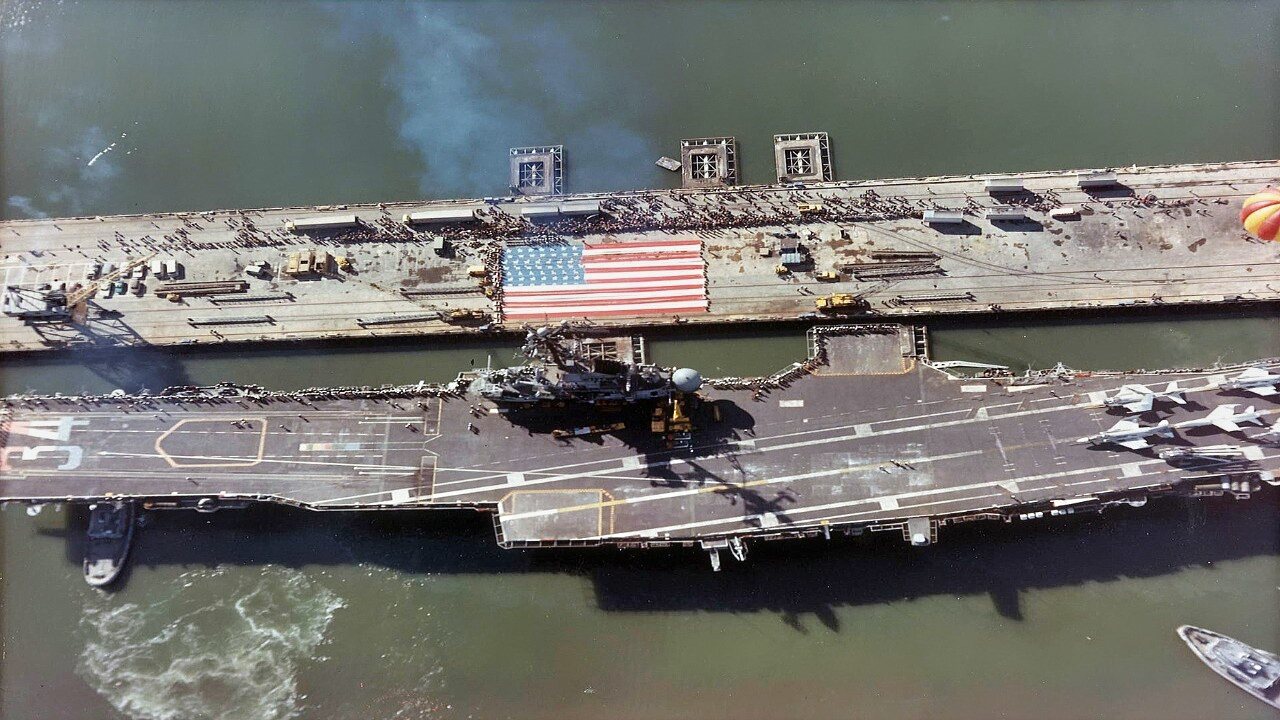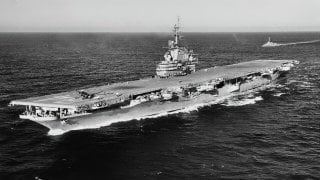USS Oriskany: The Last Essex-Class Aircraft Carrier Fought Everywhere
Just two years after being commissioned, USS Oriskany was among the U.S. Navy warships to aid the United Nations (UN) forces in Korea, where her aircraft took part in bombing and strafing attacks against enemy supply lines and coordinated bombing missions with surface strikes along the Korean coast.
USS Oriskany – the Updated Essex-class Carrier - The final Essex-class aircraft carrier to be completed, the USS Oriskany (CV/CVA-34) arrived too late to see service during the Second World War. She had only been laid down as a "long-hulled" Essex-class carrier in May 1944, and construction was suspended in 1946.
That could have been the end of the story – but seeing that the vessel was approximately 85 percent complete, the United States Navy opted to use the carrier as a test bed for the modernization of its other Essex-class flattops. Beginning in August 1947, USS Oriskany – named for one of the bloodiest battles of the Revolutionary War – was redesigned as the prototype for the SCB-27 modernization of the World War II-era carriers.
Like a house being renovated, the warship was "torn down to 60 percent" complete, and subsequently received stronger elevators, a massively reinforced flight deck, more powerful hydraulic catapults, and a new arresting gear; while the island structure was rebuilt, anti-aircraft turrets removed and new blisters added to the hull to increases the cross-sectional area of the warship, thereby increasing its buoyancy and stability.
The warship was commissioned at the New York Naval Shipyard on September 25, 1950. She was to lay the groundwork for the future of the Essex-class.
As "Jane's War at Sea: 1897-1997 – 100 Years of Jane's Fighting Ships" by Bernard Ireland and Eric Grove (Harper Collins, 1997) noted, "The late completion in 1950 of the USS Oriskany to a revised SCB-27A design with stronger flightdecks and catapults presaged some 15 conversions."
USS Oriskany: Service in Korea and Vietnam
Just two years after being commissioned, USS Oriskany was among the U.S. Navy warships to aid the United Nations (UN) forces in Korea, where her aircraft took part in bombing and strafing attacks against enemy supply lines and coordinated bombing missions with surface strikes along the Korean coast. During her deployments, embarked pilots downed two Soviet-built MiG-15 jets and damaged a third in November 1952.
Following an overhaul in late 1954, the flattop was used in the production of the Korean War-era film "The Bridges at Toko-Ri," standing in the escort carrier USS Savo Island (CVE-78).
In April 1965, during her seventh Far East Deployment, she was joined by two other carriers off the coast of Vietnam. As part of Task Force 77 (TF 77), the airwing of CVN-34 took part in Operation "Rolling Thunder." Assigned to either "Yankee" or "Dixie" Stations, carriers in TF 77 launched aircraft for interdiction missions against North Vietnamese targets and conducted close air support against Viet Cong targets in the South.
Serious Fire
While serving with the Yankee Station off Vietnam in October 1966, a fire erupted on the starboard side of the ship's forward hangar bay and raced through five decks, killing 44 men. Many who those who lost their lives were veteran combat pilots who had flown raids over Vietnam a few hours earlier.

The fire began when a pair of sailors loading a stack of Mk 24 magnesium parachute flares into the flare locker accidentally ignited one flare. Panicking, they threw it into the flare locker and shut the hatch. Soon all 700 magnesium flares in the space ignited in a chain reaction, and the fire was raging at 4,500 degrees Fahrenheit.
A subsequent explosion blew out the steel bulkheads of the flare locker, instantly killing five sailors, setting two nearby helicopters on fire, and spreading flaming debris into the forward berthing areas. It took more than seven hours to put out the fire. The ship was forced to return to San Francisco Bay Naval Shipyard for overhaul and extensive fire-damage repairs, with the work being completed by the following March – a testament to the shipyard and the vessel's design.
A True Fighting Carrier
After being returned to service, USS Oriskany resumed Yankee Station operations and also provided medical assistance to the fire-ravaged attack carrier USS Forrestal (CVA-59).
During that deployment, on October 26, 1967, then–Lieutenant Commander John McCain flew off the USS Oriskany in an A-4 Skyhawk on his 23rd bombing mission of the Vietnam War. He was shot down during that mission and remained a prisoner of war until January 1973.
The carrier returned home in January 1968, having completed 122 days of combat operations over North Vietnam. Sadly, Carrier Air Wing 16 suffered one of the highest loss rates of any naval air wing in the conflict, losing half of its assigned aircraft, while 20 of its pilots were killed and another nine taken prisoner. One factor for the heavy loss was the air wings' unrelenting pace, which included more than 9,500 sorties, including 181 air strikes into the heavily defended Hanoi-Haiphong corridor.
However, the carrier returned to Yankee Station in May 1969, but in a more restricted environment than in the previous deployment.
For her service in wartime, USS Oriskany was awarded the Navy Unit Commendation on three occasions, the Meritorious Unit Commendation three times; while she earned the Korean Service Medal and two Battle Stars, and the Vietnam Service Medal and 10 Battle Stars.
The Oriskany Reef
After the carrier was decommissioned in 1976, she remained in the reserve fleet. It was determined in the 1980s that it would be too expensive to modernize the vessel, and at the end of the Cold War, her hull was stripped of all equipment that could be reused or recycled.

Efforts to preserve the vessel as a museum fell through and she was sold for scrap in the 1990s. However, the U.S. Navy retook possession of the warship in 2004 she was transferred to the State of Florida for use as an artificial reef. She was the first former warship and largest to be intentionally sunk in U.S. coastal waters – 22 miles south of Pensacola.
The water depth to the top of the ship is 80 feet, and the flight deck is 145 feet, making the former carrier a popular dive location.
Author Experience and Expertise
Peter Suciu is a Michigan-based writer. He has contributed to more than four dozen magazines, newspapers, and websites with over 3,200 published pieces over a twenty-year career in journalism. He regularly writes about military hardware, firearms history, cybersecurity, politics, and international affairs. Peter is also a Contributing Writer for Forbes and Clearance Jobs. You can follow him on Twitter: @PeterSuciu.
All images are Creative Commons.


